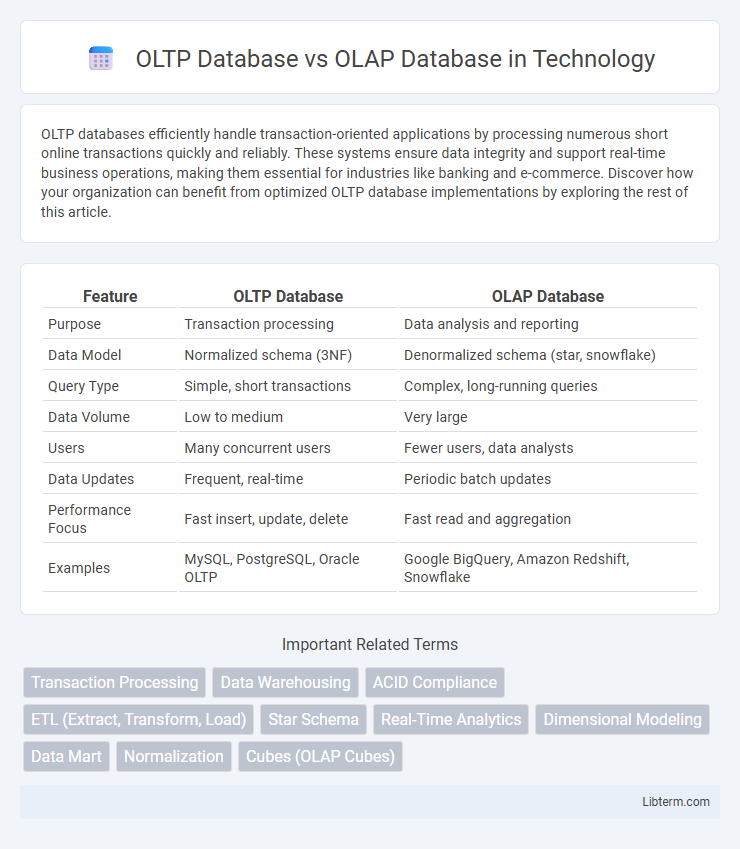OLTP databases efficiently handle transaction-oriented applications by processing numerous short online transactions quickly and reliably. These systems ensure data integrity and support real-time business operations, making them essential for industries like banking and e-commerce. Discover how your organization can benefit from optimized OLTP database implementations by exploring the rest of this article.
Table of Comparison
| Feature | OLTP Database | OLAP Database |
|---|---|---|
| Purpose | Transaction processing | Data analysis and reporting |
| Data Model | Normalized schema (3NF) | Denormalized schema (star, snowflake) |
| Query Type | Simple, short transactions | Complex, long-running queries |
| Data Volume | Low to medium | Very large |
| Users | Many concurrent users | Fewer users, data analysts |
| Data Updates | Frequent, real-time | Periodic batch updates |
| Performance Focus | Fast insert, update, delete | Fast read and aggregation |
| Examples | MySQL, PostgreSQL, Oracle OLTP | Google BigQuery, Amazon Redshift, Snowflake |
Introduction to OLTP and OLAP Databases
OLTP (Online Transaction Processing) databases are designed to manage real-time transactional data with high efficiency, supporting thousands of short online transactions such as insertions, updates, and deletions. OLAP (Online Analytical Processing) databases specialize in complex queries and analysis over large volumes of historical data, facilitating business intelligence and decision-making processes. The primary distinction lies in OLTP's optimization for transactional integrity and speed, while OLAP emphasizes data aggregation, multidimensional analysis, and read-heavy operations.
Core Definitions: OLTP vs OLAP
OLTP (Online Transaction Processing) databases are designed to manage real-time transaction data, supporting high-speed, routine operations such as insertions, updates, and deletions with strong consistency and concurrency control. OLAP (Online Analytical Processing) databases focus on complex queries and data analysis, enabling multidimensional analysis of historical data for business intelligence and decision-making purposes. OLTP systems prioritize transactional efficiency and integrity, while OLAP systems optimize query performance and data aggregation across large datasets.
Key Features of OLTP Databases
OLTP databases are designed for transaction-oriented applications with high volume and fast query processing, ensuring data integrity through ACID compliance. These systems prioritize real-time data entry and retrieval, supporting numerous concurrent users executing short, atomic transactions. Key features include normalized schemas to reduce redundancy, indexing for quick access, and efficient locking mechanisms to maintain consistency during simultaneous operations.
Key Features of OLAP Databases
OLAP databases are designed for complex queries and multidimensional analysis, enabling fast retrieval of aggregated and historical data. Key features include support for complex calculations, trend analysis, and data modeled in star or snowflake schemas to optimize query performance. These systems prioritize read-intensive operations and data summarization over transaction processing, making them essential for business intelligence and decision support.
Data Structure and Storage Mechanisms
OLTP databases utilize highly normalized schemas such as the Entity-Relationship model to ensure efficient transaction processing and maintain data integrity through row-level locking and ACID compliance. OLAP databases, in contrast, employ denormalized, multidimensional star or snowflake schemas designed for complex queries and fast aggregations, storing data in columnar formats optimized for read-heavy workloads. Storage mechanisms in OLTP focus on fast insert, update, and delete operations using row-based storage, while OLAP leverages columnar storage and indexing strategies to speed up scan and aggregation tasks across large datasets.
Performance and Query Optimization
OLTP databases prioritize fast transaction processing with optimized indexing, normalized schemas, and low-latency writes to support high concurrency and real-time data integrity. OLAP databases emphasize complex query performance, utilizing denormalized schemas, star or snowflake schemas, and advanced indexing like bitmap indexes to accelerate aggregations and multidimensional analysis. Query optimization in OLAP leverages materialized views, pre-aggregated data, and columnar storage to reduce I/O and improve analytical query response times significantly compared to OLTP systems.
Use Cases: OLTP vs OLAP
OLTP databases are optimized for managing real-time transactional data, supporting applications such as e-commerce sales, banking transactions, and order processing where fast query response and high concurrency are critical. OLAP databases are designed for complex analytical queries and data mining, ideal for business intelligence, trend analysis, and decision support systems that aggregate large volumes of historical data. Key use cases for OLTP include inventory management and payment processing, while OLAP serves forecasting, strategic planning, and reporting by enabling multidimensional analysis of large datasets.
Scalability and Maintenance Considerations
OLTP databases prioritize high transaction throughput and low latency, requiring scalable architectures that support rapid read/write operations and frequent indexing optimizations to maintain performance under heavy concurrent access. OLAP databases emphasize scalability in handling large volumes of historical and aggregated data, often leveraging columnar storage and distributed computing frameworks to ensure efficient query processing and data warehousing maintenance. Maintenance for OLTP systems involves routine backups and consistency checks to preserve data integrity in real-time environments, whereas OLAP maintenance focuses on periodic data refreshes, schema updates, and optimization of complex analytical queries to support business intelligence workloads.
Security and Data Integrity in OLTP vs OLAP
OLTP databases prioritize security and data integrity through strict transactional controls, ensuring ACID compliance for real-time processing of high-volume transactions with minimal latency. OLAP databases emphasize data integrity by maintaining complex aggregations and historical data accuracy, but their security measures are designed to support analytical querying with controlled access rather than instant transaction validation. Encryption, role-based access control, and audit trails are critical in both OLTP and OLAP systems, yet OLTP frameworks demand more robust concurrency controls and rollback capabilities to prevent data anomalies during simultaneous multi-user operations.
Choosing the Right Database for Your Business
OLTP databases excel in handling high-volume transactional operations with real-time data processing, making them ideal for customer-facing applications requiring fast inserts, updates, and deletes. OLAP databases optimize complex queries across large datasets for analytical reporting, supporting business intelligence and decision-making through multidimensional data analysis. Selecting the right database depends on your business needs: use OLTP for transactional consistency and speed, and OLAP for deep data insights and trend analysis.
OLTP Database Infographic

 libterm.com
libterm.com